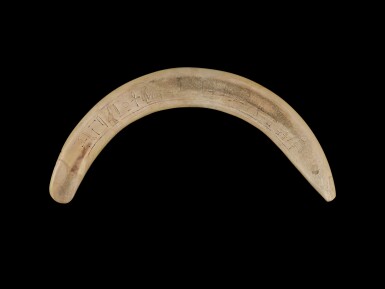Ancient Sculpture and Works of Art
Ancient Sculpture and Works of Art

Another Property
An Egyptian Hippopotamus Ivory Magic Wand, 12th/13th Dynasty, 1938-1640 B.C.
Lot Closed
July 5, 12:41 PM GMT
Estimate
5,000 - 8,000 GBP
Lot Details
Description
Another Property
An Egyptian Hippopotamus Ivory Magic Wand
12th/13th Dynasty, 1938-1640 B.C.
finely engraved on one side with a single line of hieroglyphic inscription reading “Recitation by these Gods: [we] have come [to extend protection] around the Lady of the House Seneb-Su-Heri, Alive, Sound, Healthy, Repeating Life.”
Length 35.6 cm.
Nicholas Tano (1866-1924), Cairo
by descent to Jean Tano
Sotheby’s, New York, December 17th, 1997, no. 56, illus.
Private collection, London
Finch and Co., London
Charles Ede, London
Private collection, Rome, Italy
PUBLISHED
Charles Ede, Ltd., London, Egyptian Antiquities, 2006, no. 48, illus.
Altenmüller, "Zur Bedeutung der Fabeltiere von Beni Hasan", in M. Massiera, B. Mathieu, and Fr. Rouffet, eds., Apprivoiser le sauvage/Taming the Wild (Cahiers de l'ENIM, vol. 11), Montpellier, 2015, p. 22, note 1
H. Altenmüller, Die Zeichen der Apotropaia, Stundensterne und Planeten: Zum Bildprogramm der Apotropaia des Mittleren Reiches und der Zweiten Zwischenzeit. Hützel: Backe-Verlag 2021, pp. 18, 72, 280, 281, 285, and 288
H. Altenmüller and E.F. Vink, Die Apotropaia des Mittleren Reiches und der Zweiten Zwischenzeit. Katalog, London, 2022, no.115 (forthcoming)
Compare W. C. Hayes, The Scepter of Egypt, part I, New York, 1953, pp.248-249, fig. 159, and S. D’Auria, Peter Lacovara, and C.H. Roehrig, Mummies & Magic, The Funerary Arts of Ancient Egypt, Boston, 1988, pp. 127-128, no. 59.
Hayes, op. cit., writes that “…evidences of prolonged wear on many of them indicates that such amulets were employed by the living as well as the dead. Placed around or under the beds of their owners, these magic knives apparently served to ward off snakes, poisonous insects, and similar hidden dangers. The fact that the points of the knives are often worn away on one side suggests that they were used repeatedly to draw magic circles around the living and sleeping places of the owners to render them safe.”
